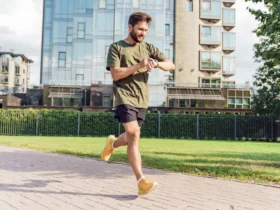Many people turn to extensive running regimes for their physical health, overlooking alternatives such as power walking that can provide significant health benefits while being gentler on the body.
This fitness approach combines endurance with mental wellness perks without the high impact of traditional jogging.
What is Power walking ?
Power walking is a form of exercise that involves walking at a brisk pace, typically between 3 to 5 miles per hour (about 5 to 8 kilometers per hour).
It is faster and more intense than casual strolling, focusing on maintaining a rapid stride.
Here are some key aspects of power walking:
- Speed and Intensity: Power walking aims to raise your heart rate, usually staying in the moderate-intensity exercise zone. It’s generally slower than jogging but faster than a leisurely walk.
- Technique: Proper form is crucial in power walking. It involves an exaggerated arm swing, a straight posture, and a rolling motion from the heel to the toe with each step.
- Purpose: This activity is often used for fitness, weight loss, and cardiovascular health. It can be a low-impact alternative to running, reducing the stress on joints.
- Duration and Frequency: Like other forms of exercise, the duration and frequency of power walking depend on fitness goals, but it typically ranges from 30 minutes to an hour, several times a week.
Power walking is popular among all age groups due to its simplicity and the minimal equipment required.
It’s an effective way to improve overall health, increase stamina, and tone muscles without the high impact of running.
The underestimated advantages of power walking
Power walking is more than just a recreational activity; it holds substantial benefits both physically and mentally.
The activity not only aids in shedding calories but also significantly tones various muscle groups including those in the abdominal area, thighs, and glutes.
Furthermore, the cardiovascular aspects of power walking assist in burning fat effectively, which promotes heart health through improved arterial function.
Mental health equally reaps advantages from this easy-to-adapt exercise.
The release of endorphins, stimulated by physical exertion from power walking, contributes to overall well-being and boosted self-esteem, making it a wholesome exercise.
Here is what you can expect to burn in one hour of power walk at 70 kg bodyweight :
| Speed (mph) 🚶 | Calories Burned (1 hour) 🔥 |
|---|---|
| 3.0 | 257 |
| 3.5 | 316 |
| 4.0 | 368 |
| 4.5 | 515 |
| 5.0 | 610 |
3 efficient techniques of Power Walking
Here are a few types of power walking that cater to different fitness levels and goals :
- Nordic Walking: Originating from Finland and influenced by cross-country skiing, Nordic Walking utilizes poles for an all-inclusive workout. It efficiently distributes weight across the body and engages multiple muscle groups simultaneously. The poles help propel the walker along, which means they work harder than usual yet the support makes it feel easier.
- Treadmill Walking : Using a treadmill for walking allows the user to control the pace and incline. Many people use treadmills for walking workouts that incorporate varying speeds and inclines, which can simulate challenging walking paths and help build endurance and leg strength.
- Weighted Walking : Carrying weights, whether hand-held weights or a weighted vest, increases the intensity of your walking workout. It’s crucial to use proper form to avoid injury, but adding weight can significantly increase calorie burn and build strength.
Pro tip : you can combine all of this in interval Walking, which involves alternating periods of fast-paced walking with slower recovery phases, adding a dynamic intensity variation that helps increase stamina over time.
Tips to make your power walking even more efficient
Power walking involves more than just walking quickly; it has specific techniques to maximize the workout benefits and improve efficiency.
Here are some key techniques for effective power walking:
- Posture: Stand tall, keep your back straight, and avoid leaning forward or backward. Good posture helps to breathe easier and walk more efficiently.
- Arm Motion: Bend your elbows at about 90 degrees and swing your arms naturally with each stride. The arm movement should be brisk and controlled, moving in sync with the opposite leg to propel you forward.
- Footwork: Strike the ground with your heel first, then roll your foot forward toward your toe. Push off with your toes to move into the next step. This rolling motion can help increase your speed and reduce the impact on your joints.
- Stride: Rather than taking overly long strides, focus on quick, short steps. Overstriding can lead to fatigue and reduce efficiency. Efficient power walking involves taking more steps, not longer ones.
- Core Engagement: Keep your core muscles lightly engaged during your walk. This helps to stabilize your torso and reduces the risk of injury. It also contributes to better balance and power in your stride.
- Breathing: Develop a rhythmic breathing pattern that matches your steps. For example, you might breathe in for three or four steps and breathe out for the same number. Efficient breathing helps maintain stamina and oxygen flow during your exercise.
- Focus and Head Position: Look forward, not down at your feet, keeping your chin parallel to the ground. This positioning helps maintain good posture and balance.
- Intensity and Pacing: Begin your walk with a 5 to 10-minute warm-up at a slower pace, then gradually increase to your power walking pace. End with a cool-down period to help your muscles recover.
Integrating power walking into your lifestyle
Beyond knowing the types and techniques, integrating power walking into your daily routine calls for strategic planning and consistency.
Here’s how you can start:
- Schedule Regular Sessions: Consistency is key. Try incorporating 30-minute walks into your schedule most days of the week.
- Vary Your Routine: Combine different forms of power walking throughout the week to keep your routine engaging and cover a broader range of muscles and skills.
- Use Proper Gear: Invest in good quality walking shoes and attire suitable for varying weather conditions, creating a comfortable walking experience regardless of external factors.
- Track Progress: Use a fitness tracker to monitor your progress and stay motivated. Watching your improvement over time can be incredibly rewarding and motivating.
In conclusion, power walking poses as an exceptional alternative to traditional forms of cardio like running, especially for individuals seeking lower impact exercises.
Its versatility and ease of integration make it apt for almost anyone looking to enhance their physical health actively.
Whether it’s through Nordic, traditional, or interval power walking, the potential health benefits are extensive, covering everything from physical toning and enhanced metabolic rates to mental happiness and improved cardiovascular function.







